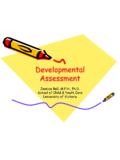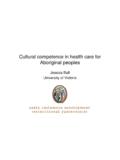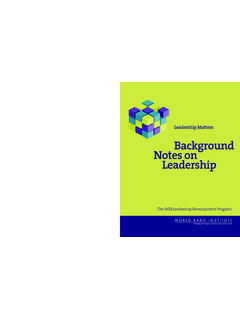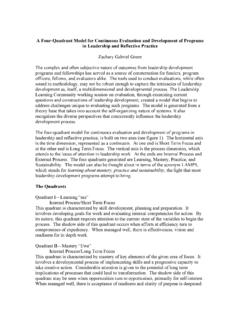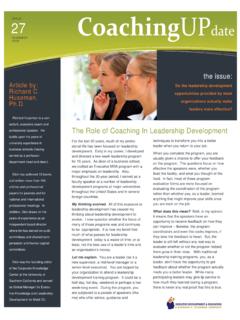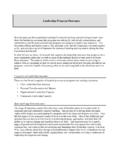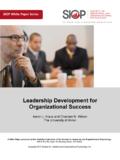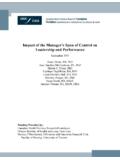Transcription of Aboriginal young children’s language and literacy ...
1 I Aboriginal young children s language and literacy development : research evaluating progress , promising practices, and needs Jessica Ball, , University of Victoria Paper Prepared for Canadian language and literacy Networked Centre of Excellence Jessica Ball, 2007 ii We re taught that our language comes from the Creator, and that speaking it acknowledges our connection. We re taught that our voice is a sacred gift and that there is a lot of power in our words. When we speak, our words go around the world forever. Sharla Peltier Speech- language Clinician, Nipissing First Nation, Ontario, Canada iii TABLE OF CONTENTS Table of Contents.
2 Iii Executive Summary .. 1 Introduction .. 4 Why ARE Aboriginal children s language and literacy PRIORITIES? .. 5 1. Aboriginal goals for children s development .. 5 2. The sensitive early years .. 5 3. The pivotal role of language in development .. 6 4. The language -thought-culture nexus .. 7 5. Success in 8 6. Social exclusion .. 8 7. Equitable opportunities for health and development .. 8 Conclusion .. 9 Speech- language and literacy needs of Aboriginal young children .. 10 2. Views from Aboriginal leaders .. 14 3. Views from the field .. 14 4. Early identification using standardized assessment tools .. 16 5.
3 School-based indicators of delayed and weak literacy development .. 16 6. Residential school effects .. 17 7. Attenuation of Indigenous language acquisition in the early years .. 18 8. Lack of resources to promote home language literacy .. 18 9. Varieties of standard English or French .. 18 10. Auditory problems .. 20 Approaches to Aboriginal language and literacy development .. 21 1. Holism .. 21 2. Key influences on Aboriginal early language development .. 22 3. Culturally appropriate practices .. 24 4. Collaborative research and 25 5. Optimizing the potential of community development approaches .. 26 Aboriginal language and literacy Promotion and Early Interventions.
4 28 1. Aboriginal Head Start .. 28 2. The Hanen Centre Programs .. 31 3. The TLC3 Project .. 32 4. Home Instruction for Parents of Preschool Youngsters (HIPPY) .. 33 5. The Native Infant Program .. 34 6. Parent-Child Mother Goose 35 7. Moe the Mouse .. 35 8. Community-wide activities .. 36 9. development of Culturally Appropriate Resources .. 37 10. Supporting Indigenous language learning .. 37 11. School-based approaches .. 40 Roles for speech- language pathologists in Aboriginal children s language and literacy development .. 43 1. Challenges for speech- language pathology services .. 43 2. New screening and assessment tools for early identification.
5 49 iv Tailoring targets to regional variations .. 51 Looking Forward .. 52 1. National consultation .. 54 2. Basic research agenda .. 54 3. Leadership development .. 55 4. Practice Recommendations .. 55 CONCLUSION .. 57 References .. 59 1 EXECUTIVE SUMMARY Aboriginal young children s language and literacy development : progress , promising Practices, and Needs* Jessica Ball, Aboriginal children s language and literacy environments and developing language and literacy skills are unique in many ways compared to non- Aboriginal children. While there are commonalities in the biological unfolding of language and literacy capacities across all children, the cultural nature of development , as well as variations in access to supports and services, call for a focused consideration of the needs of Aboriginal children and of approaches to supporting their children s language and literacy .
6 Giving children the best start in life is one of the most important investments we can make. research shows that early childhood is the developmental stage with the greatest long-term impact on quality of life. language develops rapidly from infancy throughout the preschool years. language delays and difficulties are best prevented and addressed during these early years. This report summarizes what is known about language and literacy development of Aboriginal children under six years old living in Canada. As well, the report characterizes some of the views on this topic expressed by Aboriginal leaders, parents, Elders, and early childhood educators, as well as by speech- language pathologists who have worked with Aboriginal children in Canada.
7 research selected for review to inform this report did not include the availability, nature, or impacts of programs for school-aged children or adults, such as basic education, reading recovery, bilingual education, adult literacy , or Indigenous language instruction or immersion. Also, given the rapid development of speech and language in the early years as the foundation for emerging literacy , this report focuses more on speech- language development than on literacy . The review for this report set out to identify published, peer reviewed, systematic research documenting speech- language trajectories, difficulties, and secondary problems among Aboriginal young children, and controlled research studies of speech- language promotion and early interventions delivered to Aboriginal children or families.
8 Perhaps surprisingly, this search yielded no published studies fitting these descriptions. In the absence of published research evidence, the review draws upon selected demographic data and a variety of informal sources. These include gray literature ( , unpublished agency, government, or community reports), _____ *This report was prepared for the Canadian language and literacy research Network (CLLRNet) to inform the development of a national language and literacy strategy. Views expressed are those of the author and do not necessarily represent the policies, priorities or perspectives of CLLRNet. The author thanks Carrie Gillon, , for assistance in ferreting out and assessing Canadian sources reviewed here.
9 Jessica Ball, 2007 2 consultations with scholars and community-based leaders working on Aboriginal children s speech- language and/or literacy , anecdotal reports gleaned from Aboriginal child care conferences, and research that is pertinent to but not specifically on Aboriginal early language or literacy . Throughout anecdotal and informal reports is an over-riding concern that the nature and provision of language learning environments in Aboriginal children s home and community settings should be culturally and linguistically congruent with the goals of Aboriginal parents for their children s development .
10 Given the important roles of language in securing Aboriginal children s cultural identity and their connections with family, community, and spiritual life, new approaches to culturally-appropriate supports are needed. A funded program of research is urgently needed to learn more about the language and literacy development needs of Aboriginal children and how best to support Aboriginal children s primary caregivers ( , parents, grandparents, foster parents) to promote optimal outcomes. As well, research is needed to create relevant content and effective pedagogy for pre-service and in-service education for secondary caregivers ( , early childhood educators) and specialists ( , speech- language pathologists, librarians, physicians, pediatric epidemiologists, and psychometricians) who do not necessarily subscribe to the same developmental goals or service approaches as do Aboriginal primary caregivers.

